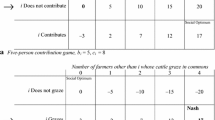Abstract
Some scholars have studiedMancur Olson's legacy by investigating theeffects of his research on the socialsciences (McLean, 2000). Others havescrutinized the logical and empiricalimplications of his theories (Sandler,1992; Marsh, 1976; Chamberlin, 1974;Frohlich and Oppenheimer, 1970). A thirdgroup have quietly claimed that hisgreatest work, The logic of collectiveaction, was little more than apopularization of earlier ideas (Dowding,1997; Chamberlain, 1966). This paperattempts to exonerate Olson of the latterclaim by reviewing the major contributionsto collective action theory before his timeand comparing them to The logic ofcollective action.
Similar content being viewed by others
References
Alt, J. (1999). Thoughts on Mancur Olson's contribution to political science. Public Choice 98: 1–4.
Bailyn, B. (Ed.) (1993). The debate on the constitution. 2 vols. New York: Library of America.
Baldwin, R.E. (1989). The political economy of trade policy. The Journal of Economic Perspectives 3: 119–135.
Baumol, W.J. ([1952] 1969). Welfare economics and the theory of the state. Cambridge, MA: Harvard University Press.
Bowen, H. (1943). The interpretation of voting in the allocation of economic resources. Quarterly Journal of Economics 58: 27–48.
Brand, D.R. (1983). corporatism, the NRA, and the oil Industry. Political Science Quarterly 98: 99–118.
Buchanan, J. (1965). An economic theory of clubs. Econonmica 35 (125): 1–14.
Chamberlain, N. (1966). The logic of collective action (book review). American Economic Review 56: 603–605.
Chamberlin, J. (1974). Provision of collective goods as a function of group size. American Political Science Review 68: 707–716.
Darden, L. (1991). Theory change in science: Strategies from Mendelian genetics. New York: Oxford University Press.
Dougherty, K.L. (2001). Collective action under the Articles of Confederation. New York: Cambridge University Press.
Dougherty, K.L. (2003). Madison's theory of public goods. In S. Kernell (Ed.), James Madison: the theory and practice of government. Stanford: Stanford University Press (forthcoming).
Dowding, K. (1997). Olson, Mancur. In N. Parker and S. Sim (Eds.), The A–Z guide to modern social and political theorists, 270–273. New York: Prentice Hall.
Downs, A. (1957). An economic theory of democracy. New York: Harper and Row.
Esteban, J. and Ray, D. (2001). Collective action and the group size paradox. American Political Science Review 95: 663–672.
Frohlich, N. and Oppenheimer, J. (1970). I get by with a little help from my friends. Journal of World Politics 23: 104–120.
Head, J. (1962). Public goods and public policy. Public Finance 27:197–219.
Hume, D. ([1739–40] 1978). A treatise of human nature. In L.A. Selby-Bigge (Ed.). Oxford, UK: Clarendon Press.
Hutchinson, W.T., Rachal, W. and Schneider, J. (Eds.) (1962-). The papers of James Madison.Chicago: University of Chicago Press.
Jensen, M. (Ed.) (1976). The documentary history of the ratification of the Constitution. Madison: State Historical Society of Wisconsin.
Kuhn, T. (1970). The structure of scientific revolutions, second edition. Chicago: University of Chicago Press.
Lindahl, E. ([1919] 1967). Just taxation – a positive solution. In R. Musgrave and A. Peacock (Eds.), Classics in the theory of public finance, 168–176. New York: St. Martin's Press.
Marsh. D. (1976). On joining interest groups: An empirical consideration of the work of Mancur Olson Jr. British Journal of Political Science 6: 257–271.
McLean, I. (2000). The divided legacy of Mancur Olson.British Journal of Political Science 30: 651–668.
Moe, T. (1980). The organization of interests. Chicago: University of Chicago Press.
Mill, J.S. ([1848] 1965). Principles of political economy, seventh edition, Vol. 3, Bk. 5.Toronto: University of Toronto Press.
Miller, A. (1981). Albert Einstein's special theory of relativity: emergence (1905) and early interpretation (1905–1911). Reading, MA: Addison-Wesley.
Mueller, D. (1998). In memoriam, Mancur Olson, 1932–1998. Public Choice 97: 531–534.
Musgrave, R. 1939. The voluntary exchange theory of public economy Quarterly Journal of Economics 53: 213–237.
Olson, M. (1965). The logic of collective action. Cambridge, MA: Harvard University Press.
Samuelson, P. (1954). The pure theory of public expenditures. The Review of Economics and Statistics 36: 387–389.
Samuelson, P. (1955). Diagramatic exposition of a theory of public expenditures. Review of Economics and Statistics 37: 350–356.
Samuelson, P. (1958). Aspects of public expenditure theories, Review of Economics and Statistics 40: 332–338.
Sandler, T. (1992). Collective action: Theory and applications. Ann Arbor: University of Michigan Press.
Syrett, H.C. and Cooke, J.E. (Eds.) (1962-). The papers of Alexander Hamilton. New York: Columbia University Press.
Tiebout, C.M. (1956). A pure theory of local expenditures. Journal of Political Economy 64: 416–424.
Author information
Authors and Affiliations
Rights and permissions
About this article
Cite this article
Dougherty, K.L. Public Goods Theory from Eighteenth Century Political Philosophy to Twentieth Century Economics. Public Choice 117, 239–253 (2003). https://doi.org/10.1023/B:PUCH.0000003734.55916.8d
Issue Date:
DOI: https://doi.org/10.1023/B:PUCH.0000003734.55916.8d




